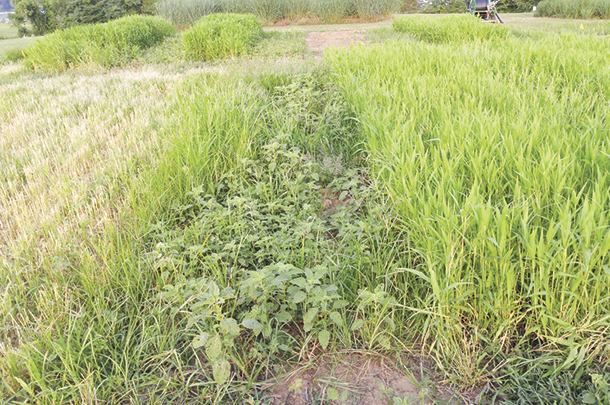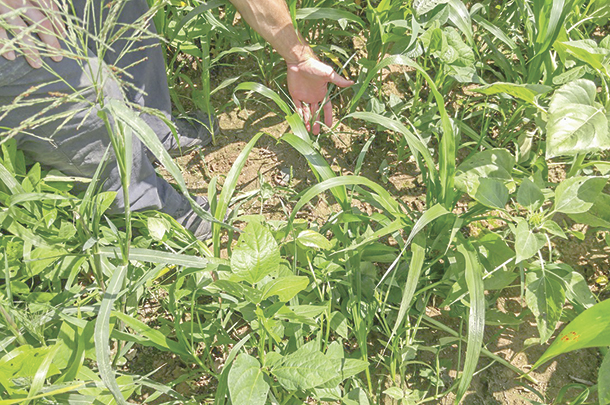Their goal as seedlings is to grow a deep root system. Harvesting any forage from these seedlings robs them of the energy they need to grow that deep root system that provides so many benefits down the road. Think drought tolerance, think high yield, think soil health. So is there a way to have our cake and eat it too? Can we grow vigorous seedlings and somehow coax some grazing or hay out of the field all in the same season?
Many years ago, I was working with a sharp, innovative young producer helping him establish a switchgrass pasture. When I came back a few weeks later to see how things were developing, I found he had planted some millet with the switchgrass as a nurse crop. Now, we have always emphasized that competition control is a key to successful native grass establishment, and here he had planted something that, it seemed to me, was head-to-head competition.
I thought, we are in trouble here. Well, remember the part about him being sharp and innovative? He timed a hay harvest just about right. What did he end up with? A cutting of millet hay and a very respectable switchgrass stand.
I have often thought about that experience and wondered if we could replicate it, if this could be a recommendation that producers could routinely follow during establishment of native grasses. I finally got the opportunity to find out when we started a study here at the University of Tennessee through a USDA Agriculture and Food Research Institute grant. In 2016, we planted browntop millet (trying to avoid more robust species such as pearl millet) 18 days after planting switchgrass and big bluestem. This time lag was included to accommodate the slow germination of the native species (about 21-24 days normally) and the relatively quick germination of the millet.
How did it work? The good news was the millet successfully suppressed weeds (Photo 1).

The bad news though, was that the combination of weeds and millet created more competition overall for the native grass seedlings. Thus, by fall dormancy, big bluestem and switchgrass stands had fewer seedlings in plots where millet had been planted than in the unplanted controls.
We repeated the trial in 2017, and because of heavy rains following planting of the native grasses, planting the millet was delayed a few days beyond our 18-day target. More importantly, all the rain brought on an abundance of weed seedlings that were able to compete with the millet. These weeds kept the millet from developing as fully as it had in 2016. As a result, in 2017 we had as many native grass seedlings with millet as without – and harvested some hay in the meantime. Hay yields averaged 1.2 tons (dry matter basis) per acre.
In both years, we had difficulty timing the planned harvests due to weather and field conditions. The fast-growing millet was able to quickly close canopy and impact the developing seedlings. So although in one of two years we realized the goal of having our cake and eating it too, the margin of error seemed too tight for this approach, at least with this nurse crop, to be reliable.
So how to solve this problem of not being able to harvest the nurse crop when it needs to happen? How about grazing instead of hay harvest? Yup, that’s what we thought too. So in 2019, working with partners at the Greenacres Foundation in Ohio, we started a second trial, this time relying on grazing instead of mechanical harvest to remove the summer annual. In addition to the browntop millet, we included a second nurse crop, a high diversity blend that included a sorghum-sudan hybrid, sunflowers, cowpeas, radish and a brassica.
Despite being kept out of the field until early July by relentless rainfall, we ended up with abundant summer forage with both nurse crops and plenty of grazing. However, once again, timing was an issue. Rapid growth of the annuals, a few days delay in initiating the grazing, and a lighter stocking rate than what we needed all added up to the very same problem we encountered in our first study – too much nurse crop and not enough native grass seedlings (Photo 2).

We plan to repeat the trial in 2020 – hopefully with more success. After all, experience is the best teacher. The take-home lesson from 2019 was the need to be more timely – and aggressive – in the grazing.
These two studies have taught us a lesson about nurse crops. They can work. But managing the canopy of the nurse crop, and doing so at the right time, is absolutely essential. Missing that target means you will lose ground with the nurse crop and seedlings will be overtopped, weakened, and in many cases, die.
This is exactly what we observed in the 2019 trial: Well-stocked native grass seedling stands among the nurse crops early on, but substantial reductions in those seedling populations following the tremendous growth of the nurse crops. It seems clear that a well-timed removal of this growth would have made a big difference in seedling survival and development.
While the additional forage provided by the nurse crop can be very helpful for off-setting what would otherwise be a year of lost production, it could come at the cost of a well-established perennial crop. So a gain in one year for what may be less production for many years to come.
Despite these setbacks, I remain optimistic that there is an attainable “sweet spot” in terms of nurse crop density and management that can work. But it seems unlikely it will ever be a solution that can be implemented without paying attention to what you are doing. Somehow, the term “straight and narrow” comes to mind rather than, “broad and easy.” ![]()
PHOTO 1: A USDA-funded nurse crop trial at University of Tennessee is pictured in late June 2016. Note the heavy canopy of browntop millet and lack of weeds in plot at right (foreground). By contrast, the unplanted control plot (center foreground) has an abundant population of broadleaf and grassy weeds. Clipping millet (plot on left foreground) 44 days post-planting removed the heavy canopy, but not soon enough to maintain good native grass seedling populations.
PHOTO 2: A post-grazing, high-diversity nurse crop at Greenacres Foundation site in Ohio is pictured in late summer 2019. Note the big bluestem seedling in front of the student’s hand. Although many seedlings survived the heavy growth of the summer annual, populations were reduced by the end of the season versus control plots. Photos by Patrick Keyser.
The studies described in this article are part of the research being conducted by two Utah Ph.D. students, Johnny Richwine (USDA trial) and Keagan Swilling (Greenacres Foundation trial).

-
Patrick Keyser
- University of Tennessee Institute of Agriculture, Center for Native Grasslands
- Email Patrick Keyser







